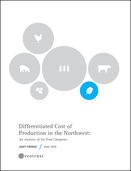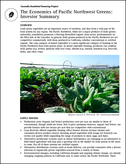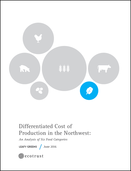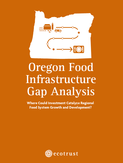Organic Leafy Greens |
Research Chapters
|
|
Overview
Leafy green vegetables are an important source of nutrition, and thus form a vital part of the food system for any region. The Pacific Northwest, while not a major producer of leafy greens nationally, nonetheless possesses a thriving diversified organic farm sector, predominantly on the West side of the Cascades. In general, leafy greens produced in the Pacific Northwest are not competitive commercially with those produced in California, whether conventional or certified organic. The crop category of mixed vegetables is a more significant category of farming in the Pacific Northwest than leafy greens alone. In mixed vegetable farming, producers can combine leafy greens (e.g. lettuce, spinach) with root crops, alliums (e.g. onions), brassicas (e.g. broccoli), herbs, and other crops. Supply Drivers
Supply Drivers
Opportunities The complexity, uncertainty, and poor data quality that characterizes the organic leafy greens sector means that we cannot recommend specific areas to invest, but we can offer some guiding principles for those seeking to make catalytic investments in organic leafy greens and related mixed vegetable crops. The most important thing to remember for a prospective impact investor seeking to move the market in organic leafy greens – or organic vegetables in general -- is: pay attention. There is no clear, dominant trend in organic leafy green vegetable agriculture, so sustained attention to the details of the market, including emerging crops, new production systems, and alternative methods of distribution, is essential for identifying future profitable opportunities. Trends to watch:
For more detail on the economics of greens production in the Pacific Northwest download Production Analysis: Greens from the right sidebar. |
Downloadable FilesBelow are combined and individual files related to greens production and infrastructure opportunities in WA and OR. To stay informed about next steps from this research please share appropriate information below.
Combined FileIndividual Files |











